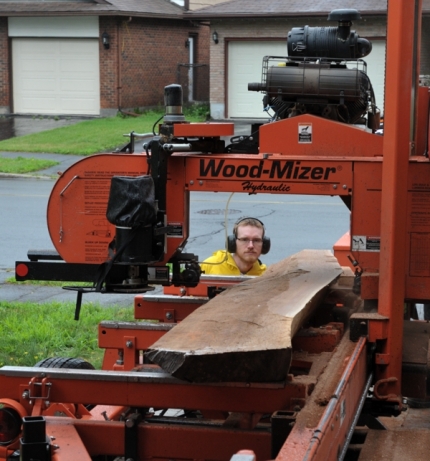So you'll notice that a lot of my guitars share a common material element: Black Walnut (juglans nigra).This majestic tree furnishes the rich chocolate-brown timber used somehow in almost all of my guitars. In life, its broad spreading canopy provides us with shade and delicious nuts. For more information on this and other locally grown nut trees, visit: ECSONG. Here's a modest example growing in Waupoos, Ontario:

About 12 years ago, I had the opportunity to purchase a whole walnut log- a new highway onramp was being built on what used to be a long century-old farm laneway. What I got was an enormous tree trunk over three feet across and eight feet long. After splitting it into eight wedges the majority got put into storage to slowly air-dry. Walnut has distinctly lighter-coloured sapwood a few centimetres thick; to remedy this, most commercial lumber is kiln-dried. This has the advantage of evening out the colour; it has the drawback of evening out the colour! Wood like mine that has been exclusively air-dried has much better colour- deep warm chocolate brown with occasional golden stripes and highlights. Ten years after it was felled, I hired a portable sawmill to finish the job. It was thrilling to see plank after plank of beautiful clear lumber being revealed:

The upshot is that I've ended up with enough heirloom-quality lumber to make literally dozens of guitars, not to mention several pieces of furniture including my one-of-a-kind woodshop workbench (more on that in another post sometime).
Until very recently black walnut has been one of the most overlooked and underrated of tonewoods. Despite centuries of use in the best furniture and a reputation as the premier carving wood of the new world, somehow guitar builders felt compelled to use tropical timbers instead. In the second half of the 20th century, precious Cuban Mahogany (swietenia mahoganii) was in short supply. In searching for a substitute, they settled on the related Honduras Mahogany (swietenia macrophylla). But it's not the same thing! It is lighter in weight and colour, weaker and coarser in texture. Take a look at a pre-war mahogany guitar and you can see the difference. They could have done better: Black Walnut is among the most stable woods, rarely warping or cracking. It is stiff and low damping, but moderate in density. (full mechanical specifications here). In terms of the acoustic tone of a guitar, its influence is warm but assertive. The colour is dark, the wood is easy to work and finish, and often displays great chatoyance when the grain is wavy. It should rightfully be regarded as the new Mahogany, albeit far more sustainably grown. And it's just gorgeous:

Sankey Guitars made using Black Walnut:
Corduroy, Peekaboo, Rippling Book, Sweet Dreams, Spaltecaster, The Brown Bomber, The Fish, Mapledip, The Bird, Caramellow, Cherub
